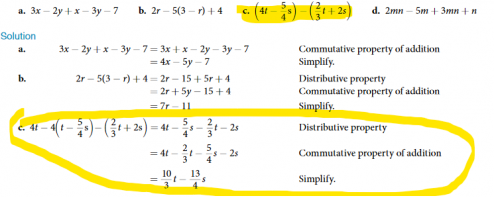I'm taking an online algebra course for college credit and working through the textbook. This is an example in the textbook that I'm having trouble understanding:
(4t - 5/4s) - (2/3t + 2s) becomes somehow through the distributive property? :
4t - 4(t - 5/4s) - (2/3t + 2s) or maybe this is the step with the distributive property?
4t - 5/4s - 2/3t - 2s at this point I can understand how the commutative property gets used to obtain
4t - 2/3t - 5/4s - 2s and then just simplify (I'll skip that step here)
it's the first two steps that I'm having trouble wrapping my head around, any help is greatly appreciated.
(4t - 5/4s) - (2/3t + 2s) becomes somehow through the distributive property? :
4t - 4(t - 5/4s) - (2/3t + 2s) or maybe this is the step with the distributive property?
4t - 5/4s - 2/3t - 2s at this point I can understand how the commutative property gets used to obtain
4t - 2/3t - 5/4s - 2s and then just simplify (I'll skip that step here)
it's the first two steps that I'm having trouble wrapping my head around, any help is greatly appreciated.



